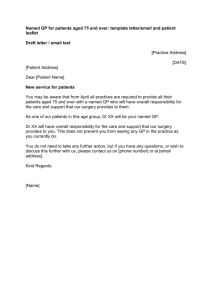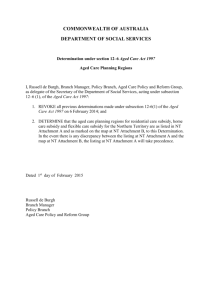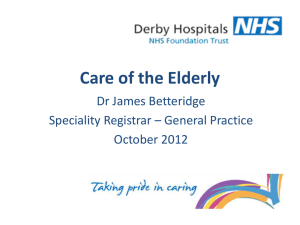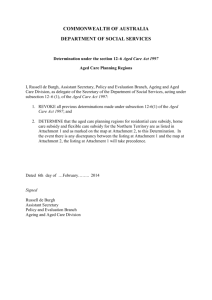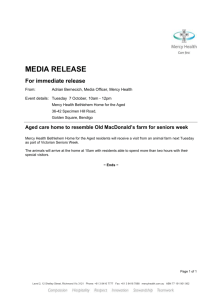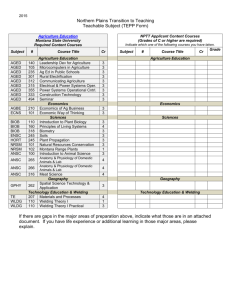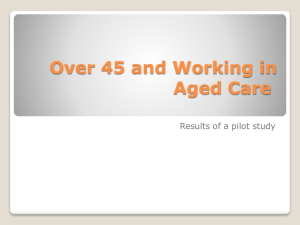2013–14 Concise Facts & Figures in Aged Care
advertisement
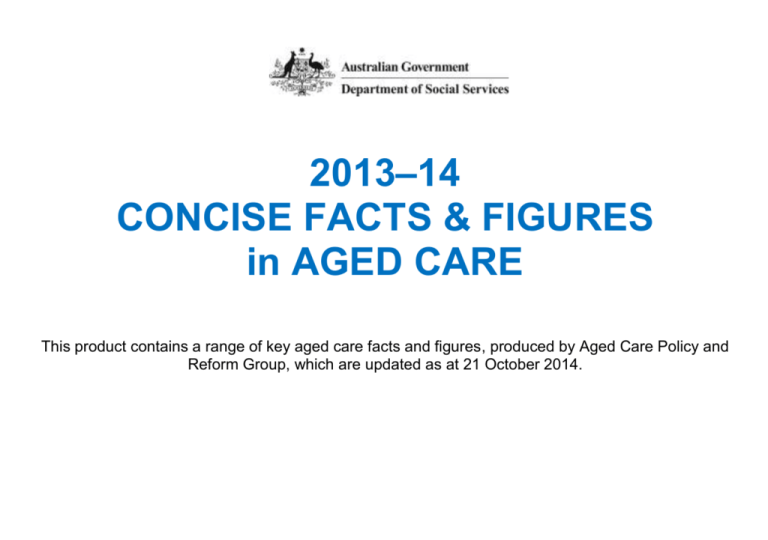
2013–14 CONCISE FACTS & FIGURES in AGED CARE This product contains a range of key aged care facts and figures, produced by Aged Care Policy and Reform Group, which are updated as at 21 October 2014. TABLE OF CONTENTS 1. PLACES, SERVICES & PROVIDERS ………………………………………….... 3 1.1 Operational aged care places (30 June 2014) …………………...................................................... 3 1.2 Operational aged care ratios (30 June 2014) ……………………………………………………………. 4 Main points on 30 June 2014 Stocktake ……………………………………….……………...… 5 1.3 Operational providers and services (30 June 2014) .……….………………………………….….. 6 1.4 Operational aged care places 2010–2014 ……………..….……………………………………... 7 1.5 Operational aged care ratios 2010–2014 …………………….……………………………..…… 8 1.6 Ownership of all operational aged care places (organisation type) (30 June 2014) ………..…….… 9 1.7 Distribution of all operational aged care places & 70+ population by remoteness (30 June 2014). 10 1.8 2012–13 Aged Care Approvals Round - Summary of new places, ZRIL & grants …………….. 11 2. RESIDENTS and CARE RECIPIENTS …………………………………………... 12 2.1 2.2 2.3 2.4 2.5 2.6 2.7 People in aged care places 2010–2014 …………………..……………………………………… 12 ABS projected number of older Australians in future years …………………..…………............ 13 Percentage of people in aged care born in non-English speaking countries (2010–2014) ….......... 14 People in aged care (30 June 2014) ……………………………………………………………… 15 Percentage of people in aged care with preferred language other than English (2010–2014) ……. 17 Occupancy in aged care by programme type (2009–10 to 2013–14) ……………………………….. 18 Number of HACC clients aged 65 years and older (2013–14) ……………………………………... 19 1 2.8 National Respite for Carers Programme – number of primary carers assisted (2013–14) ……… 20 2.9 Number of ACAP assessments completed (2012–13) ……………………………..………..………. 21 3. WORKFORCE ……………………….…………………………………………..… 22 3.1 Aged care workforce, all PAYG employees & direct care workers (30 March 2012) …..………… 22 3.2 Percentage of direct care employees in the aged care workforce (30 March 2012) ……..…..…….. 23 4. EXPENDITURE …………………………………………………………….….…… 24 4.1 Average accommodation bond agreed with new residents (2009–10 to 2013–14) ………..………. 24 4.2 Estimated Australian Government funding (2014–15 to 2017–18) …………………….………….... 25 2 1. PLACES, SERVICES & PROVIDERS 1.1 Total number of all operational aged care places (30 June 2014) State/ territory NSW Vic Qld WA SA Tas ACT NT Australia Residential care (a) 66,780 49,921 34,208 16,238 18,077 4,880 2,073 657 192,834 Home care low (b) Home care high (c) 17,307 13,062 9,710 4,863 4,427 1,334 691 871 52,265 3,826 2,977 3,107 2,921 846 343 487 182 14,689 Total home Total residential + home care care (a) 21,133 87,913 16,039 65,960 12,817 47,025 24,022 7,784 5,273 23,350 1,677 6,557 1,178 3,251 1,053 1,710 66,954 259,788 Transition care Grand total 1,378 89,291 1,000 66,960 733 47,758 346 24,368 347 23,697 109 6,666 58 3,309 29 1,739 4,000 263,788 Source: 30 June 2014 Stocktake of Australian Government Subsidised Aged Care Places. (a) Includes places in Multi-purpose services (MPS), National Aboriginal & Torres Strait Islander Flexible Aged Care Programme & Innovative Care. (b) Includes Home care places level 1 and level 2 and home care places in MPS, National Aboriginal & Torres Strait Islander Flexible Aged Care Programme & Innovative Care. (c) Includes Home care places level 3 and level 4 only. 3 1.2 Total operational aged care ratios (places per 1,000 people aged 70 years and over) (30 June 2014) State/ territory Residential care (a) Home care low (b) Home care high (c) Total home Total residential Transition care care (a) plus home care Grand total (planning ratio) NSW 84.5 21.9 4.8 26.7 111.2 1.7 112.9 Vic 84.1 22.0 5.0 27.0 111.1 1.7 112.8 Qld 78.8 22.4 7.2 29.5 108.3 1.7 110.0 WA 74.4 22.3 13.4 35.7 110.0 1.6 111.6 SA 91.5 22.4 4.3 26.7 118.2 1.8 120.0 Tas 80.0 21.9 5.6 27.5 107.5 1.8 109.2 ACT 70.6 23.5 16.6 40.1 110.7 2.0 112.7 NT 76.4 101.3 21.2 122.5 198.9 3.4 202.2 Australia 82.6 22.4 6.3 28.7 111.3 1.7 113.0 Source: 30 June 2014 Stocktake of Australian Government Subsidised Aged Care Places. (a) Includes places in MPS, National Aboriginal & Torres Strait Islander Flexible Aged Care Programme and Innovative Care. (b) Includes Home care places level 1 and level 2 and home care places in MPS, National Aboriginal & Torres Strait Islander Flexible Aged Care Programme and Innovative Care. (c) Includes Home care places level 3 and level 4 only. Note: The national operational planning target ratios are 80.0 for residential care and 45.0 for home care (total of 125.0) places per 1,000 people aged 70 years and over to be met by 2021–22. 4 Main points on 30 June 2014 Stocktake of Australian Government Subsidised Aged Care Places 192,834 operational residential care places (of which 189,283 were non-flexible places) (a) 66,954 operational home care places (b) (of which 66,149 places were Level 1 to 4 under the Home Care Packages Programme) 259,788 operational residential and home care places (b). In addition there are 4,000 operational transition care places 82.6 operational residential care places per 1,000 people aged 70 years and over. (84.5 in 2013.) 28.7 operational home care places per 1,000 people aged 70 years and over. (27.2 in 2013.) 111.3 is the operational planning ratio (residential + home care ratio). (111.7 in 2013.) (a) Flexible places include residential care places in Multi-purpose services (MPS), National Aboriginal and Torres Strait Islander Flexible Aged Care Programme services and Innovative Care services. (b) Includes flexible places in MPS, National Aboriginal and Torres Strait Islander Flexible Aged Care Programme services and Innovative Care services. Note: The national operational planning target ratios are 80.0 for residential care and 45.0 for home care (total of 125.0) places per 1,000 people aged 70 years and over to be met by 2021–22. 5 1.3 Number of operational providers and services (30 June 2014) Care type Residential care (non-flexible) (a) Number of all providers Number of all Number of all Number of all providers in services in rural/ services rural/ remote(c) remote(c) 1,016 483 2,688 1,024 504 294 2,212 940 1,277 634 4,900 1,964 24 24 147 147 Innovative care 8 4 9 4 Transition care 10 9 87 43 National Aboriginal & Torres Strait Islander Flexible Aged Care Programme 30 26 30 26 1,328 678 5,173 2,184 Home care (non-flexible) (a) Residential care & home care (a)(b) Multi-purpose services (MPS) Grand total (all care types) (b) Source: 30 June 2014 Stocktake of Australian Government Subsidised Aged Care Places. (a) (b) (c) Excludes Multi-purpose services (MPS), Innovative Care & National Aboriginal & Torres Strait Islander Flexible Aged Care Programme services. The number of operational providers is a unique total. Rural/remote is defined here as all ABS Remoteness Areas excluding Major Cities. 6 1.4 All operational Australian Government subsidised aged care places 2010–2014 (30 June) Care type Residential care Home care(a) Total residential & home care Transition care Grand total 2010 2011 2012 2013 2014 182,936 185,559 187,941 189,761 192,834 51,530 58,471 60,949 61,087 66,954 234,466 244,030 248,890 250,848 259,788 2,698 3,349 4,000 4,000 4,000 237,164 247,379 252,890 254,848 263,788 Source: 30 June 2010 to 30 June 2014 Stocktakes of Australian Government Subsidised Aged Care Places. (a) From 2010 to 2013 data includes CACP, EACH & EACH Dementia packages and all flexible community care places in Multi-purpose services (MPS), Innovative Care and under the National Aboriginal & Torres Strait Islander Flexible Aged Care Programme. On 1 August 2013 the Home Care Packages Programme replaced the former community packaged care programmes –Community Aged Care Packages (CACP), Extended Aged Care at Home (EACH) packages and EACH Dementia packages. The 2014 figure also includes all flexible home care places included in flexible services prior to 2014. 7 1.5 Total operational aged care ratios (places per 1,000 people aged 70 years and over) 2010–2014 (30 June) (a) Care type 2010 2011 2012 2013 2014 Residential care 86.8 85.8 84.4 84.5 82.6 Home care(b) 24.5 27.0 27.4 27.2 28.7 111.3 112.8 111.8 111.7 111.3 1.3 1.5 1.8 1.8 1.7 112.5 114.3 113.6 113.5 113.0 Total residential & home care (planning ratio) Transition care Grand total Source: 30 June 2010 to 30 June 2014 Stocktakes of Australian Government Subsidised Aged Care Places. (a) The national operational planning target ratios are 80.0 for residential care and 45.0 for home care (total of 125.0) places per 1,000 people aged 70 years and over to be met by 2021–22. (b) From 2010 to 2013 data includes CACP, EACH & EACH Dementia packages and all flexible community care places in Multi-purpose services (MPS), Innovative Care & under the National Aboriginal & Torres Strait Islander Flexible Aged Care Programme. On 1 August 2013 the Home Care Packages Programme replaced the former community packaged care programmes –Community Aged Care Packages (CACP), Extended Aged Care at Home (EACH) packages and EACH Dementia packages. The 2014 figure also includes all flexible home care places included in flexible services prior to 2014. 8 1.6 Ownership of all operational aged care places by provider organisation type (30 June 2014) (per cent) (a) Provider organisation type Residential care Home care Total Not-for-profit 57% 81% 63% For-profit 37% 10% 30% 7% 9% 7% 100% 100% 100% State & local gov. Total Source: 30 June 2014 Stocktake of Australian Government Subsidised Aged Care Places. (a) Includes flexible places in Multi-purpose services (MPS), Innovative Care & National Aboriginal & Torres Strait Islander Flexible Aged Care Programme services but excludes the 4,000 Transition Care places. Notes: The Transition Care places are operated by state & territory governments. Percentages have been rounded and may not add to 100%. 9 1.7 Distribution of all operational aged care places and Australia 70+ population by remoteness (30 June 2014) (per cent)(a) Major cities 68.4 68.8 Total residential + home care 68.5 Inner regional 21.4 20.5 21.2 22.4 Outer regional 8.8 8.1 8.6 9.9 Remote 0.9 1.2 1.0 1.0 Very remote 0.5 1.4 0.7 0.4 100% 100% 100% 100% ABS remoteness classification Total Residential care Home care (b) Australia 70+ population 66.2 Source: 30 June 2014 Stocktake of Australian Government Subsidised Aged Care Places & customised Australian population projections prepared for DSS by the ABS, according to assumptions set by DSS. (a) Includes all operational flexible places in Multi-purpose services (MPS), Innovative Care and National Aboriginal & Torres Strait Islander Flexible Aged Care Programme services but excludes the 4,000 Transition Care places. (b) Places are based on the physical address of the services and may not correspond to where the care is delivered. Note: Percentages have been rounded and may not add to 100%. 10 1.8 2012–13 Aged Care Approvals Round – Summary of new aged care places, ZRIL & grants allocations (announced 5 July 2013) State/ territory Number of residential places Number of home care packages(a) level 1 level 2 level 3 level 4 Total Estimated annual recurrent funding ($m) Zero real Interest loans ($m) Capital grants ($m) NSW 2,302 485 1,075 375 210 2,145 145.9 36.7 2.2 Vic 2,235 350 854 272 150 1,626 142.3 27.4 23.6 Qld 2,011 245 780 210 65 1,300 129.8 40.4 12.7 WA 811 30 30 10 10 80 50.6 25.0 2.8 SA 185 135 200 100 71 506 21.7 17.2 3.2 Tas 51 50 50 35 15 150 5.9 9.7 6.5 ACT 180 – – – – – 8.0 – – – 8 8 8 4 28 1.1 – – $505.3m $156.4m $51.0m NT Total 7,775 1,303 2,997 1,010 525 5,835 – Nil (a) These places were counted as allocated (not operational) in the 30 June 2013 Stocktake of Australian Government Subsidised Aged Care Places. On 1 August 2013 the Home Care Packages Programme replaced the former community packaged care programmes – Community Aged Care Packages (CACP), Extended Aged Care at Home (EACH) packages and EACH Dementia packages. 11 2. RESIDENTS and CARE RECIPIENTS 2.1 Number of people in Australian Government subsidised aged care places 2010–2014 (30 June) (a) Care type Residential care (permanent & respite) Home care (b) Total residential & home care Transition care Grand total 2010 2011 2012 2013 2014 166,338 168,998 171,065 173,094 176,816 47,642 50,853 53,975 56,515 59,739 213,980 219,851 225,040 229,609 236,555 2,269 2,869 3,367 3,424 3,339 216,249 222,720 228,407 233,033 239,894 Source: Cognos Core Cross Program Analysis cube and 2014 home care data from DSS Ageing and Aged Care Data Warehouse sourced from the DHS Payment System. (a) Excludes residents and care recipients in flexible services in Multi-purpose services (MPS), National Aboriginal & Torres Strait Islander Flexible Aged Care Program services and Innovative Care. (b) From 2010 to 2013 data includes CACP, EACH & EACH Dementia packages only. On 1 August 2013 the Home Care Packages Programme replaced the former community packaged care programmes – Community Aged Care Packages (CACP), Extended Aged Care at Home (EACH) packages and EACH Dementia packages. 12 2.2 ABS projected number of older Australians in future years (June) Age group 2014 2024 2034 2044 2054 Number of older Australians (’000) 65 years + 3,451 4,737 6,064 7,140 8,392 70 years + 2,332 3,364 4,552 5,486 6,307 75 years + 1,514 2,194 3,107 3,874 4,476 80 years + 904 1,224 1,887 2,519 2,984 85 years + 455 595 955 1,349 1,662 90 years + 161 229 339 552 754 23,524 27,690 31,665 35,401 39,036 Total population Per cent of total population 65 years + 14.7 17.1 19.2 20.2 21.5 70 years + 9.9 12.1 14.4 15.5 16.2 75 years + 6.4 7.9 9.8 10.9 11.5 80 years + 3.8 4.4 6.0 7.1 7.6 85 years + 1.9 2.1 3.0 3.8 4.3 90 years + 0.7 0.8 1.1 1.6 1.9 Source: ABS Population Projections, Australia, 2012 to 2100 (Cat. No. 3222.0) series B (2013). 13 2.3 Percentage of residents and consumers in aged care born in non-English speaking countries in aged care 2010–2014 (30 June) (per cent) Programmes 2010 2011 2012 2013 2014 16.0 16.5 16.9 17.5 17.9 Home care 22.8 23.1 23.3 23.5 24.0 Total residential & home care 17.5 18.0 18.4 19.0 19.5 Residential care (permanent & respite) Source: Cognos Core Cross Program Analysis cube and 2014 home care data from DSS Ageing and Aged Care Data Warehouse sourced from the DHS Payment System. Note: Excludes people who did not respond on the Aged Care Client Record (ACCR) to the question, ‘In which country was the client born?’ 14 2.4 Number of people in aged care (30 June 2014) Residential care Home care packages (a) Transition care All HACC (2013–14) (b) 176,816 59,739 3,339 n.a. 254,929 83,144 23,519 996,127 84.5 82.3 80.3 71.7 Proportion aged 65+ 96% 96% 95% 77% Proportion aged 70+ 93% 91% 87% 69% Proportion aged 80+ 77% 66% 59% 42% Proportion aged 90+ 31% 18% 14% 9% 69% 68% 63% 63% 0.8% 3.8% 0.7% 3.0% 18% 24% 21% 20% People Number of people Number of distinct people who received care any time during 2013–14 Average age (years) Proportion female Proportion indigenous (self-reported) (c) Proportion CALD (d) (permanent & respite) 15 Source: 2013–14 Home and Community Care Minimum Data Set (unpublished), Cognos Core Cross Program Analysis cube and home care data from DSS Ageing and Aged Care Data Warehouse sourced from the DHS Payment System. Note: Residential and Home care data are for non-flexible services only, i.e. excludes residents and care recipients in Multi-purpose services (MPS), Innovative Care and indigenous people who access the 30 National Aboriginal & Torres Strait Islander Flexible Aged Care Programme services. Data on the number of people as at 30 June 2014 and during 2013–14 is not for public release before 2013–14 RoACA is published in late November 2014. (a) (b) Includes home care places level 1 to 4 only. It excludes home care places in flexible services in MPS, Innovative Care & National Aboriginal & Torres Strait Islander Flexible Aged Care Programme services. 775,959 of all the 996,127 Home and Community Care (HACC) clients were aged 65 years and over (50 years and over for Aboriginal & Torres Strait Islander people) in the Commonwealth HACC Programme (NSW, Qld, SA, Tas, ACT & NT) and the joint HACC Programme in Vic and WA. (c) No data is available on indigenous people in National Aboriginal & Torres Strait Islander Flexible Aged Care Programme services, MPS or Innovative care so data in this category is incomplete. (d) Includes people born overseas in countries other than Main English speaking countries (i.e. the United Kingdom, Ireland, New Zealand, Canada, United States of America and South Africa). n.a.: Not available. 16 2.5 Percentage of residents and consumers in aged care with preferred language other than English 2010–2014 (30 June) (per cent) Programmes 2010 2011 2012 2013 2014 9.6 9.6 9.6 9.6 9.5 Home care 14.8 14.7 14.3 14.1 n.a. Total residential & home care 10.7 10.8 10.7 10.7 n.a. Residential care (permanent & respite) Source: Cognos Core Cross Program Analysis cube and 2014 home care data from DSS Ageing and Aged Care Data Warehouse sourced from the DHS Payment System. Notes: Includes people whose preferred language was Australian Indigenous. Excludes people who did not respond on the Aged Care Client Record (ACCR) to the question, ‘What language(s) are spoken at home?’ n.a.: Not available–due to missing home care data from DHS new payment system. 17 2.6 Occupancy in aged care by programme type (2009–10 to 2013–14) (per cent)(a) Programmes 2009–10 2010–11 2011–12 2012–13 2013–14 Residential care 92.4 93.1 92.8 92.7 93.0 Home care 92.2 91.0 90.3 92.0 88.4 Source: Cognos Occupancy cube and updated figures from the 2013–14 Cognos Residential Occupancy cube and updated 2013–14 home care data from DSS Ageing and Aged Care Data Warehouse sourced from the 2013–14 DHS Payment System. (a) Excludes residents and care recipients in Multi-purpose services (MPS), Innovative Care and National Aboriginal & Torres Strait Islander Flexible Aged Care Programme places. Note: On 1 August 2013 the Home Care Packages Programme replaced the former community packaged care programmes – Community Aged Care Packages (CACP), Extended Aged Care at Home (EACH) packages and EACH Dementia packages. 18 2.7 Number of Home and Community Care (HACC) clients aged 65 years and older (2013–14) (a) NSW Vic Qld WA SA Tas ACT NT Australia 229,332 217,745 152,583 57,599 83,370 22,708 10,556 2,066 775,959 Source: 2013–14 Home and Community Care Minimum Data Set (unpublished). (a): HACC clients aged 65 years and over (50 years and over for Aboriginal & Torres Strait Islander people) in the Commonwealth HACC Programme (NSW, Qld, SA, Tas, ACT & NT) and the joint HACC Programme in Vic and WA. 19 2.8 National Respite for Carers Programme (NRCP) – number of primary carers assisted (2013–14) Carers assisted Total carers assisted NSW Vic Qld WA SA Tas ACT NT Australia 31,981 23,551 20,678 9,850 8,429 7,258 3,399 1,610 106,756 Note: National Respite for Carers Programme includes carers assisted through Commonwealth Respite and Carelink Centres. 20 2.9 Number of aged care assessments completed under the ACAP (2012–13)(a) NSW Vic Qld WA SA Tas ACT NT Australia 60,996 53,374 30,640 18,097 13,338 4,854 2,089 892 184,280 (a) Data is sourced from the Ageing and Aged Care Data Warehouse from the ACAP Minimum Data Set. 21 3. WORKFORCE (October 2012 estimates) 3.1% of the Australian workforce works (as PAYG employees) in aged care (Sept 2014) 90% of direct care workforce are female (in both residential and community sectors) 27.2% aged 55+ years (residential, direct care) compared to 17.2% in overall workforce Predominantly employed on a part-time, permanent basis 72% residential, 62% community. 3.1 Size of the aged care workforce, all PAYG employees & direct care workers (30 March 2012) Employees Residential workforce Community workforce Total aged care workforce Direct care 147,086 (61%) 93,359 (39%) 240,445 (100%) 55,258 (49%) 56,442 (51%) 111,700 (100%) 72.7% 62.3% 68.3% 27.3% 37.7% 31.7% 202,344 (100%) 149,801 (100%) 352,145 (100%) Non-direct care % direct care % non-direct of all PAYG employees All PAYG employees Source: Based on data from the 2012 National Aged Care Workforce Census and Survey, conducted by the National Institute of Labour Studies (NILS). 22 3.2 Percentage of direct care employees in the aged care workforce (30 March 2012) (per cent) Employees Residential care Community care Registered nurse (RN) 14.9 8.2 Enrolled nurse (EN) 11.5 3.9 0.2 0.2 Personal care attendant (PCA) / community care worker (CCW) 68.2 81.4 Allied health professional (AHP) 1.8 4.2 Allied health assistant (AHA) 3.4 2.1 100% 100% Nurse practitioner (NP) Total Source: Based on data from the 2012 National Aged Care Workforce Census and Survey, conducted by the National Institute of Labour Studies (NILS). 23 4. EXPENDITURE 4.1 Average accommodation bond agreed with new residents by financial year 2009–10 to 2013–14 ($’000) Category 2009–10 2010–11 2011–12 2012–13 2013–14 Standard care 216 227 232 244 n.a. Extra Service 293 321 347 357 n.a. All care types $233 $248 $260 $273 n.a. Not-for-profit organisations 221 233 236 251 n.a. For-profit organisations 256 278 298 309 n.a. State/ local gov. owned 165 179 181 192 n.a. Source: 2012–13 data are based on preliminary results from the 2013 Survey of Aged Care Homes (SACH) and are subject to further refinement following detailed analysis of the survey results. Notes: 92 per cent of residential aged care facilities (non-flexible) responded to the 2012–13 SACH. 36 per cent of newly admitted residents in 2012–13 paid a bond. n.a.: Not available. 4.2 Estimated Australian Government funding ($million) (2014–15 Budget Figures Including Indexation Pause) Major category 2014–15 2015–16 2016–17 2017–18 Residential care (a) 10,507.3 11,094.3 11,747.7 12,510.6 Home care (b) 1,363.5 1,539.1 1,736.4 1,942.5 Basic support at home (c) 2,502.6 2,002.3 2,083.1 2,177.1 Flexible and short term aged care(d) 507.4 538.9 567.7 599.8 Information, quality and capacity building (e) 433.3 458.4 454.6 424.9 $15,314.2 $15,633.0 $16,589.5 $17,654.8 Total aged care (a) Funding excludes Multi-purpose services (MPS), National Aboriginal & Torres Strait Islander Flexible Aged Care Programme and Innovative Pool services. (b) Excludes flexible home care places in MPS, Innovative Pool Services and National Aboriginal & Torres Strait Islander Flexible Aged Care programme services. (c) Includes Commonwealth Home and Community Care (HACC) Programme and joint HACC Programme in Vic and WA, HACC Planning and Development, HACC for Veterans, Veterans Home Care, Day Therapy Centres, Assistance with Care and Housing for the Aged, National Respite for Carers Programme and DVA Community Nursing. (d) Includes National Aboriginal and Torres Strait Islander Flexible Aged Care Programme services, MPS, Innovative Pool Services, Transition Care and continence support. (e) Includes workforce programmes, capital assistance, aged care assessment and information and support programmes such as Gateway, Carelink and Community Visitors Scheme.
